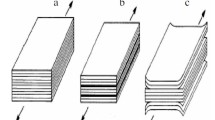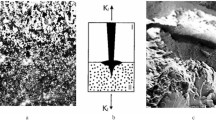Abstract
A methodical approach to the estimation of the localization zone and geometric parameters of delamination defects in layered composite materials is discussed. It is based on mathematical processing of the experimental results of deformation measurements obtained with a grid of fiber-optic sensors. The results of methodological developments related to the determination of the optimal topology of the grid of sensors are shown to ensure the detection of defects of a given size with the necessary accuracy and determination of their parameters. Methods for computational analysis and simulation of the strain-stress state in the defect zone based on the algorithm used for modeling the problems of strain-stress analysis in the defect zone using 2D finite elements instead of 3D ones are reported. These procedures allow one to use models of lower dimensionality while retaining all the features of the strain-stress state. The results of methodological developments related to the determination of the defect parameters from the results of strain measurements using the methodology of solving the inverse problem are shown. This methodology is based on solving the problem of minimizing the discrepancy between the vector of deformation response and the vector of initial parameters. The technique is implemented as software consisting of a series of macros for ANSYS and programs for MATLAB. The results of cyclic testing of a sample made of a multilayer composite material with a delamination type of defects are presented. The increment in the defect size upon loading is estimated by the mathematical processing of data recorded by fiber-optic strain sensors glued on one of the sample surfaces based on the solution of the inverse problem. Comparison of the results of calculations of geometric parameters of the defects with the measurement data obtained by the method of ultrasonic flaw detection shows good agreement between them.






Similar content being viewed by others
REFERENCES
Chernyshev, S.L., New stage of application of composite materials in aircraft manufacturing, Probl. Mashinostr. Avtom., 2013, no. 1, pp. 3–10.
Kablov, E.N., Sivakov, D.V., Gulyaev, I.N., Sorokin, K.V., Fedotov, M.Yu., Dianov, E.M., Vasil’ev, S.A., and Medvedkov, O.I., Application of optical fiber as strain sensors in polymer composite materials, Vse Mater., 2010, no. 3, pp. 10–15.
Davis, C., Tejedor, S., Grabovac, I., Kopczyk, J., and Ravis, T., High-strain fiber Bragg gratings for structural fatigue testing of military aircraft, Photonic Sens., 2012, vol. 2, no. 3, pp. 215–224.
Di Sante, R., Fibre optic sensors for structural health monitoring of aircraft composite structures: Recent advances and applications, Sensors, 2015, vol. 15, pp. 18666–18713.
Polilov, A.N., Eksperimental’naya mekhanika kompozitov (Experimental Mechanics of Composites), Moscow: Mosk. Gos. Tekh. Univ. im. N.E. Baumana, 2015.
Cherepanov, G.P., Mekhanika razrusheniya kompozitsionnykh materialov (Fracture Mechanics of Composite Materials), Moscow: Nauka, 1983.
Handbook of Composites, Lubin, G., Ed., New York: van Nostrand Reinholt, 1982.
Matvienko, Yu.G., Tendentsii nelineinoi mekhaniki razrusheniya v problemakh mashinostroeniya (Trends in Nonlinear Fracture Mechanics in Machine Engineering), Moscow: Inst. Komp. Issled., 2015.
Urnev, A.S., Chernyatin, A.S., Matvienko, Yu.G., and Razumovskii, I.A., Computer simulation of crack-like defects in the laminated composite material, Mashinostr. Inzh. Obraz., 2017, no. 3 (52), pp. 64–72.
Chernyatin, A.S. and Razumovskii, I.A., Complex analysis of constructions’ elements with surface cracks, Mashinostr. Inzh. Obraz., 2011, no. 1, pp. 66–76.
Chernyatin, A.S. and Razumovskii, I.A., Methodology and software package for assessment of stress-strain state parameters of full-scale structures and its application to a study of loading level, defect rate, and residual stress level in elements of NPP equipment, Strength Mater., 2013, vol. 45, no. 4, pp. 506–511.
Razumovskii, I.A., Chernyatin, A.S., and Fomin, A.V., Experimental-computational methods for determination of the stress-strain state of structural components, Inorg. Mater., 2014, vol. 50, no. 15, pp. 1528–1536.
Funding
This work was supported by the Russian Foundation for Basic Research, project no. 17-08-00886.
Author information
Authors and Affiliations
Corresponding author
Additional information
Translated by V. Avdeeva
Rights and permissions
About this article
Cite this article
Urnev, A.S., Chernyatin, A.S., Matvienko, Y.G. et al. Experimental and Numerical Sizing of Delamination Defects in Layered Composite Materials. Inorg Mater 55, 1516–1522 (2019). https://doi.org/10.1134/S0020168519150147
Received:
Published:
Issue Date:
DOI: https://doi.org/10.1134/S0020168519150147




